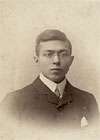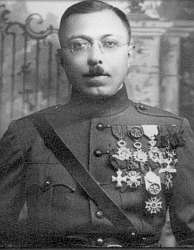Louis Grondijs
Lodewijk Hermen Grondijs (25 September 1878, Pamekasan – 17 March 1961 The Hague) was a Dutch war correspondent and byzantinist.
Grondijs was born in the Dutch East-Indies, now known as Indonesia, and via his mother was one eighth Indonesian. He spent most of his youth in the East Indies and graduated in 1896 from grammar school in Surabaya. A gifted academic, he graduated in mathematics and physics at Utrecht University in 1905 and continued his studies in philosophy and mathematics at Leiden University. In 1907 with J.D. Bierens de Haan he founded the Journal of Philosophy Tijdschrift voor Wijsbegeerte and in the 1930s he became a leading expert in Byzantology.

Working as a teacher at the Dordrecht Technical Institute in 1914, he quit his post when the Great War broke out and secured a position as war-correspondent for the Dutch newspaper Nieuwe Rotterdamsche Courant. He went into neighboring Belgium where he covered the early events of the war in Aerschot, the German war crimes at Leuven as well as the siege of Antwerp. He published a book on his experiences in Belgium, The Germans in Belgium - Notes by a Dutch Eye-Witness and afterwards traveled to France, working as a war-correspondent for various international newspapers and news-magazines. For saving fifty Belgian clergymen from German execution during the Rape of Belgium period, including the rector magnificus of the famous Catholic University of Leuven, he was decorated officer in the Belgian Order of the Crown.
Later in September 1915, he left for Russia at the invitation of general Aleksei Brusilov where he was allowed to accompany the Russian 8th Army as a correspondent of The Daily Telegraph. Many of his vividly written articles on warfare on the Eastern Front were published in the prestigious French newsweekly l'Illustration. He apparently respected the fighting qualities of the common Russian soldier and expressed his admiration numerous times in his articles. And although an academic by profession, he seemed to relish the adventure and excitement of war-time journalism and of warfare itself; he is said to have taken active part in combat along with his Russian hosts on many occasions. For this, he was decorated with the Imperial Russian Order of St. George, Order of St. Stanislaus, Order of St. Anna and Order of St. Vladimir.

He was present in Petrograd during the initial February Revolution in 1917, but after the Bolshevist take-over, he left for White controlled territory where he joined counter-revolutionary armies of generals Lavr Kornilov and Mikhail Alekseev and reported on the Russian Civil War. In June 1918 he was the only western war correspondent to join the Volunteer Army in the Kuban Campaign. Oddly he appears to have found the time to obtain a doctor's degree in physics at the university of Charkov in 1917 on the thesis Elektromagnetische Feldgleichungen bewegter Systeme. In 1918 he became an accredited war-correspondent to the French government, for which later that year he travelled to the USA, Japan and the Russian Far East. In the US he met former president Teddy Roosevelt and Tomáš Masaryk who became in 1920 president of Czechoslovakia. From Japan he returned to Russia, holding the honorary rank of captain in the French Army and following and reporting on events with the French Military Mission in Siberia during the years 1918-1920. For this, he was decorated with the French Légion d'Honneur á titre militaire and the Order of the Rising Sun of Japan. He married Antonie Therese Marie Thekla van Embden in 1908, and divorced her in the late 1910s. During the Russian Civil War, he married Valentine de Gontjarenko Petrenko, a concert pianist. After the definitive Bolshevist victory he returned to Europe, openly professing his anti-Bolshevist views in articles and lectures.
In the early 1920s he settled in Paris working for the Laboratoire des Recherches Physiques of the Sorbonne and studying history of arts and Byzantology. In 1928 he returned with his wife Valentine to The Netherlands. He once again took up the profession of academic lecturer and in 1935 became a full professor of Byzantine history and art at Utrecht University. In the 1930s he made several academic research travels to Eastern and South-Eastern Europe and was involved in archaeological excavations. Love of adventure and war must have been irresistible, for he later went to Manchuria to report on the Japanese invasion of Manchuria. He met with Chiang Kai-shek, Puyi and Thubten Chökyi Nyima the Panchen Lama. In 1936-37 he was in Spain during the Spanish Civil War, afterwards in 1939 accompanying the Hungarian army as it occupied Ruthenia, as a result of the Munich Agreement.
In 1941 he obtained his second doctor's degree at the Sorbonne with the thesis L'iconographie byzantine du Crucifié mort sur la croix. During World War II German occupation of The Netherlands, by virtue of his anti-Bolshevist sympathies, he appears to have been asked to publish articles and give lectures praising National Socialist policies. His openly expressed appreciation of the bravery of Russian fighting-men, based upon his first-hand experiences during the Great War, did little to endear him to the occupying German and collaborating Netherlands authorities and he was dropped from favor, apparently narrowly missing incarceration because of these views.
Still, his contacts with right-wing, authoritarian political movements before and during the Second World War, were well-known and as a result he experienced minor troubles after the war ended. In the end he was absolved and returned to his academic post, retiring in 1949. He passed on in 1961, at the age of 81 while practising the sport of fencing, one of his favorite pastimes.
External links
- Biography by M.C. Jansen at the Institute for Dutch History website (in Dutch)
- Les Allemands en Belgique
- Les Aigles du Tsar